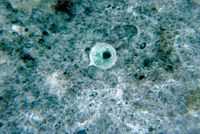Gene transcriptions/Elements/GAAC
< Gene transcriptions < Elements
The GAAC element is usually a core promoter element containing guanine (G), adenine (A), and cytosine (C), "able to direct a new transcription start site 2-7 bases downstream of itself, independent of TATA and Inr regions."[1]
Genetics

Genetics involves the expression, transmission, and variation of inherited characteristics.
Def. a "branch of biology that deals with the transmission and variation of inherited characteristics, in particular chromosomes and DNA"[2] is called genetics.
Promoters

Although human DNA like most other life forms on Earth has two strands forming a double helix, only one of the strands, the template strand, is usually used to transcribe a gene product such as messenger ribonucleic acid (mRNA).
On the template strand is a nucleotide sequence (the gene promoter) that is usually interacted with by the transcription mechanism before any product of the gene is transcribed.
Consensus sequences
The consensus sequence in the direction of transcription on the template strand is 3'-GAACT-5'.[1] T is thymine.
Dispersed promoters
A dispersed promoter contains "several start sites over 50–100 nucleotides and [is] typically found in CpG islands in vertebrates".[3] "CpGs are ... relatively enriched around the TSS. In fact, the enrichment pattern peaks sharply close to the core promoter 15 bp upstream of the TSS".[4] Normally a C (cytosine) base followed immediately by a G (guanine) base (a CpG) is rare in vertebrate DNA because the cytosines in such an arrangement tend to be methylated.
"[I]n vertebrates dispersed promoters are more common than focused promoters."[3]
General transcription factors II D
This element also controls the rate of transcription initiation and interacts in a sequence-specific manner with the transcription factor II D (TFIID) complex.[1]
Entamoeba histolytica
The GAAC element is present "in 31/37 protein-encoding E. histolytica genes ... It has a variable location between the TATA box and the Inr sequences".[1]
Human genes
"The genes encoding the two type I collagen chains are selectively activated in ... fibroblasts and osteoblasts [within the promoter by] a sequence located between -3.2 and -2.3 kb".[5] "[T]wo short elements ... tendon-specific element (TSE) 1 and TSE2 [within this sequence are] necessary to direct reporter gene expression".[5] The binding sequence of TSE2 "corresponded to an E-box."[5] TSE1 and TSE2 need to cooperate with each other and "other cis-acting elements of the proximal promoter to activate gene expression in tendon fibroblasts."[5] "[A] short sequence [in TSE1 contains] a GAACT motif that [binds] a tendon-specific nuclear protein."[5]
Original research
- See also: Original research inquiry and Research
Hypothesis:
- A1BG is not transcribed by a GAAC element.
- See also: Control groups, Proof of concept, and Proof of technology
See also
References
- 1 2 3 4 Upinder Singh, Joshua B. Rogers (August 21, 1998). "The Novel Core Promoter Element GAAC in the hgl5 Gene of Entamoeba histolytica Is Able to Direct a Transcription Start Site Independent of TATA or Initiator Regions". The Journal of Biological Chemistry 273 (34): 21663-8. doi:10.1074/jbc.273.34.21663. http://www.jbc.org/content/273/34/21663.full. Retrieved 2013-02-13.
- ↑ "genetics, In: Wiktionary". San Francisco, California: Wikimedia Foundation, Inc. April 16. 2014. Retrieved 2014-05-07.
- 1 2 Tamar Juven-Gershon, Jer-Yuan Hsu, Joshua W. M. Theisen, and James T. Kadonaga (June 2008). "The RNA Polymerase II Core Promoter – the Gateway to Transcription". Current Opinion in Cell Biology 20 (3): 253-9. doi:10.1016/j.ceb.2008.03.003. http://www.ncbi.nlm.nih.gov/pmc/articles/PMC2586601/. Retrieved 2013-02-13.
- ↑ Serge Saxonov, Paul Berg, and Douglas L. Brutlag (January 31, 2006). "A genome-wide analysis of CpG dinucleotides in the human genome distinguishes two distinct classes of promoters". Proceedings of the National Academy of Sciences USA 103 (5): 1412-7. doi:10.1073/pnas.0510310103. http://www.pnas.org/content/103/5/1412.full. Retrieved 2013-02-13.
- 1 2 3 4 5 Catherine Terraz, Gaelle Brideau, Pierre Ronco and Jérôme Rossert (May 24, 2002). "A Combination of cis-Acting Elements Is Required to Activate the Pro-α1(I) Collagen Promoter in Tendon Fibroblasts of Transgenic Mice". The Journal of Biological Chemistry 277 (21): 19019-26. doi:10.1074/jbc.M200125200. http://www.jbc.org/content/277/21/19019.long. Retrieved 2013-02-13.
Further reading
- Upinder Singh, Joshua B. Rogers (August 21, 1998). "The Novel Core Promoter Element GAAC in the hgl5 Gene of Entamoeba histolytica Is Able to Direct a Transcription Start Site Independent of TATA or Initiator Regions". The Journal of Biological Chemistry 273 (34): 21663-8. doi:10.1074/jbc.273.34.21663. http://www.jbc.org/content/273/34/21663.short. Retrieved 2013-02-13.
External links
- African Journals Online
- Bing Advanced search
- GenomeNet KEGG database
- Google Books
- Google scholar Advanced Scholar Search
- Home - Gene - NCBI
- JSTOR
- Lycos search
- NCBI All Databases Search
- NCBI Site Search
- Office of Scientific & Technical Information
- PubChem Public Chemical Database
- Questia - The Online Library of Books and Journals
- SAGE journals online
- Scirus for scientific information only advanced search
- SpringerLink
- Taylor & Francis Online
- WikiDoc The Living Textbook of Medicine
- Wiley Online Library Advanced Search
- Yahoo Advanced Web Search